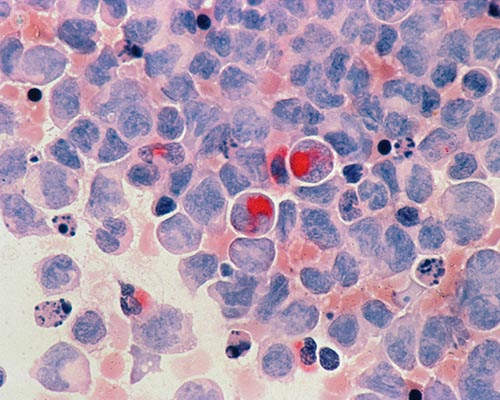Diffuse large B-cell lymphoma: explained
Escrito por:Diffuse large B-cell lymphoma (DLBCL) is a relatively uncommon cancer which affects more males than females. Leading consultant haematologist Dr Graham Collins discusses the cancer, including its prognosis and treatment options.

What are the symptoms and early warning signs of diffuse large B-cell lymphoma?
Diffuse large B-cell lymphoma (DLBCL) is a form of high-grade (or aggressive) non-Hodgkin lymphoma. It is the most common type of lymphoma. The first symptom for many people is a lump in the neck, armpit or groin.
However, DLBCL can occur anywhere in the body and the symptoms can vary greatly. For example, DLBCL affecting the bone can cause a bone break (or fracture). If it affects the bowel, it can cause abdominal pain and vomiting and if it affects the lungs, it can provoke a cough and breathlessness.
Although uncommon, DLBCL can affect the brain, which leads to confusion and weakness.
How is diffuse large B-cell lymphoma diagnosed, and what are the diagnostic tests involved?
The only way to diagnose DLBCL is through a biopsy of an affected area. This is usually done using an ultrasound probe to guide a biopsy needle, with a local anaesthetic to deaden any pain. Sometimes an involved l
If a lymph node is involved, in some cases, it will be completely removed, through a short operation. Occasionally a bone marrow biopsy will be required.
Blood tests will be needed to check to see whether chemotherapy drugs can be used and the appropriate dose. A PET or CT scan is also required to determine exactly where the lymphoma is (a process called staging). Additionally, a heart scan (echo) may be needed if any chemotherapy drugs have the potential to damage the heart.
What are the treatment options for diffuse large B-cell lymphoma, and what are the potential side effects?
DLBCL can be cured with antibody drugs (usually rituximab) combined with chemotherapy drugs, in about 60-70% of cases. The main chemotherapy combinations used are CHOP (which is 3 chemotherapy drugs and a steroid called prednisolone) or Pola-CHP (here a targeted agent called polatuzumab vedotin replaces one of the chemotherapy drugs in CHOP).
Side effects include:
- fatigue
- nausea
- change in taste
- risk of infection
- infusion reactions
- mild nerve damage (which causes pins and needles or numbness in the fingers and toes)
- heart damage (which is rare but important) and constipation.
The steroid component can also affect mood and reduce the strength of the bones. In susceptible patients, the steroid may also cause a rise in blood sugar levels, referred to as steroid-induced diabetes. People who already have diabetes need to monitor their blood sugars more closely.
What is the prognosis for diffuse large B-cell lymphoma, and what factors can affect it?
Approximately 60-70% of patients with DLBCL are cured with treatment. For those that are cured, they will enjoy a normal life expectancy. Patients who are very unwell at diagnosis, who have multiple sites in the body that are involved, who are older (over 60 years of age) and who have a raised level of an enzyme called LDH in the blood, have a slightly worse prognosis. However, even in very advanced stage disease, a cure is often achievable with the right treatment.
Unfortunately, for patients in which lymphoma returns, a cure is more difficult to achieve. However, intensive approaches such as a stem cell transplant or CAR T-cell therapy (a type of immunotherapy) can be used to treat the cancer successfully.
Furthermore, in modern medicine, newer drugs which redirect the immune system to the lymphoma (such as bispecific antibodies) are being increasingly used.
Are there any lifestyle changes or supportive measures that can help manage diffuse large B-cell lymphoma?
During treatment, it is important to reduce the risk of developing an infection. In order to do this, it is advisable to avoid crowded spaces and to keep a distance from people who have an obvious infection.
That being said, it is important to maintain mental well-being, therefore keeping in contact with friends and loved ones is important. Additionally, nutrition is important and maintaining a good calorie intake will help the body to heal.
Gentle exercise is encouraged, but it is important not to overexert yourself. You must listen to the body and rest when your body is tired.
If you would like to book a consultation with Dr Collins, do not hesitate to do so by visiting his Top Doctors profile today.


